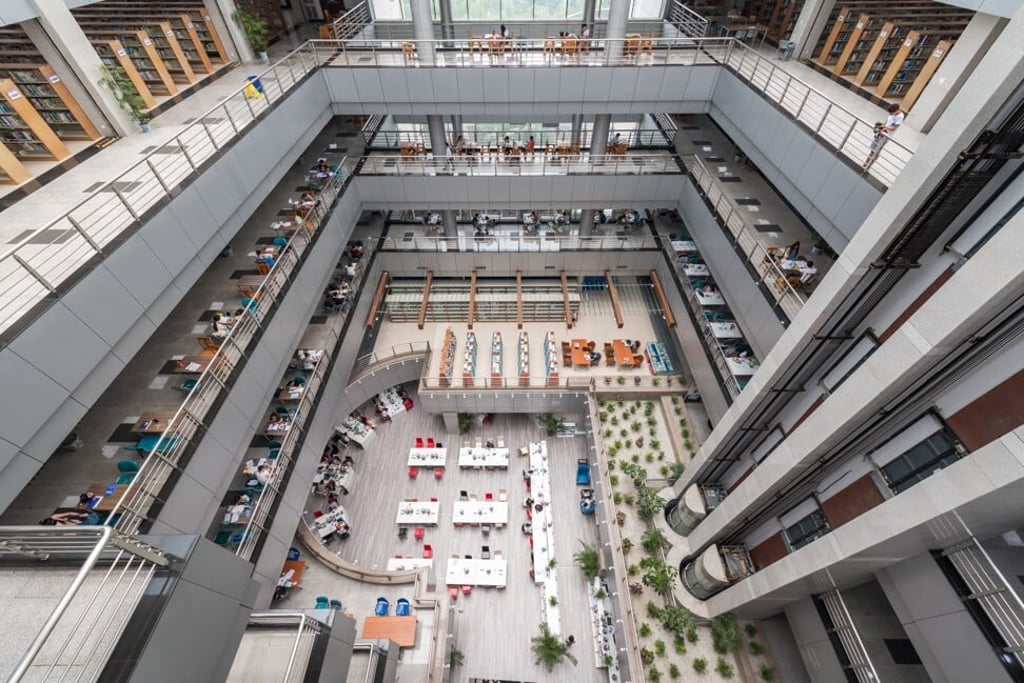How China’s new ‘city cluster’ of Cheng-Yu can become fourth powerhouse to drive nation’s economic growth
- Chengdu and Chongqing municipality megalopolis to emulate those of Yangtze River Delta, Beijing-Tianjin-Hebei and Guangdong-Hong Kong-Macao Greater Bay Area
- New area, with extensive transport network, rich pool of talent and thriving hi-tech hubs, looks well placed to be ‘Silicon Valley of China’s west’

In recent years, Chengdu, the capital of Sichuan province – an important financial, business and cultural centre in southwest China – has been attracting greater global news coverage. Long regarded as the gateway to Western China, the city’s reputation as an innovative hi-tech hub has been increasing.
Only 269km (165 miles) away to the east lies Chongqing – a megacity that is close, both geographically and culturally, to Sichuan. In 1997 it was designated as one of the country’s only four provincial-level municipalities (Beijing, Shanghai and Tianjin are the others) to manage the resettlement of about 1.2 million people along the Yangtze River following construction of the Three Gorges Dam.
Chongqing municipality – one of the world’s largest cities, which includes the city of Chongqing and neighbouring unconnected cities – has a population of more than 31 million people and covers an area of 82,400 square km (about 31,800 square miles) – just slightly smaller than the area of the European nation of Austria. Yet despite its size, it is often regarded as “the metropolis you’ve never heard of”.

The change in its status accelerated its centuries-long “rivalry” with neighbouring Chengdu for the role as the region’s economic hub.
However, since January 2020 the two cities have been jointly attracting attention and enjoying new, harmonious relations after China’s top policymakers at the Central Financial and Economic Affairs Commission (CFEAC) proposed combining them into a city cluster, Cheng-Yu – comprising the whole of Chongqing municipality, Chengdu and 14 other cities – which will form the nation’s fourth economic powerhouse.
The new cooperation between the two cities started with Chengdu’s efforts to speed up its eastward development plans. In May, the Sichuan government officially licensed the Chengdu Eastern New Area – a move that will expedite the city’s expansion and integration with Chongqing.
Chengdu Tianfu International Airport, which will be one of China’s largest commercial airports when it goes into service next summer, will help to speed up development of the landlocked New Area and form part of a new aviation economic zone.
China’s top policymakers hope the city cluster of Cheng-Yu – comprising the whole of Chongqing municipality, Chengdu and 14 other cities – will form the nation’s fourth economic powerhouse
The New Area announced the establishment of the Civil Aviation Technology Zone on September 10. Created in partnership with China’s Civil Aviation Administration, it will be the nation’s first civil aviation demonstration park and feature an aviation engineering base, innovative talent development centre, and core aviation technology hub.
The provincial government has invested 10.6 billion yuan (US$1.5 billion) in the first phase of the project, which is expected to be completed in 2023.
The future city cluster, with its name derived from Cheng for Chengdu and Yu – a historic name for Chongqing – will also benefit from its geographical position on the upper reaches of the Yangtze River.
It lies right along the corridor of the nation’s Belt and Road Initiative, an ambitious collection of development and infrastructure plans stretching from East Asia to Europe, which seeks to deepen investment and trade partnerships between China and nations throughout Asia, Africa and Europe. The Belt and Road plan was inspired by the ancient Silk Road trading route linking Xi’an in central China with the Mediterranean.
The CFEAC wants the proposed city cluster to become a thriving megalopolis in the west of China, just like those in the highly developed Yangtze River Delta to the east, the Guangdong-Hong Kong-Macao Greater Bay Area to the south, and the Beijing-Tianjin-Hebei city cluster to the north.
Cheng-Yu’s rich range of higher-education institutions, led by Chengdu’s Sichuan University, will help turn its huge population base into a talent incubator in technology, finance and other industries
Government figures put the gross domestic product of the Cheng-Yu city cluster area at 5.09 trillion yuan in 2017, contributing to about 6.2 per cent of the national total.
The Yangtze River, which is an important source of transport and commerce, has already spawned city clusters along its lower and middle reaches, led by Shanghai and Wuhan, respectively. Cheng-Yu, once fully incorporated into Yangtze River’s water transport network, will play a vital role in enhancing the economic development of the river’s upper reaches.

While the routes into China’s mountainous west have been historically described as “more daunting than climbing the sky”, both Chengdu and Chongqing have already developed transport advantages to boost their economic growth.
Rail networks running from China’s northern province of Shaanxi and the northwestern province of Gansu, for example, have been built into the Sichuan Basin. The Lanzhou-Chongqing railway forms one of the major arteries of China’s rail network, connecting Chongqing with northwestern China.
In addition, both Chongqing and Chengdu are crucial hubs on the Belt and Road strategy’s expansive rail network connecting southwestern China with Europe.
Cheng-Yu’s distinctive advantages in the hi-tech industry will provide a formidable foundation as it transforms into the ‘Silicon Valley in China’s west’
The 10,500km transcontinental rail link, Chengdu-Europe Express Rail, for example, which runs from Chengdu to Nuremberg in Germany, is the fastest Eurasian freight route. The Chongqing-Xinjiang-Europe Railway passes through east European nations, such as Belarus, on its way to Germany, too.
However, the vast economic potential of the Cheng-Yu city cluster is built on more than its extensive rail transport network. Its distinctive advantages in the hi-tech industry will provide the formidable foundation as it transforms into the “Silicon Valley in China’s west”.

While Chengdu is home to hundreds of thriving software start-ups, including the online English education platform, Baicizhan, and the photo-editing app, Camera360, Chongqing houses a massive hardware industry that has attracted information technology giants including HP, Foxconn, Quanta Computer and Inventec.
With the support of municipal investments in the hi-tech sector, Chengdu also appeals to leading Chinese tech giants such as Tencent, Alibaba – which owns the South China Morning Post – and Ant Group, all of which have either set up research centres or subsidiary companies in the city.
Meanwhile, its hardware-oriented neighbour to the east, Chongqing, was China’s third-largest mobile phone manufacturing base in 2019 – behind its southern and central competitors, Guangdong and Henan, respectively – according to data from Qianzhan Industry Research Institute.
Chengdu has a rich pool of talent as the capital of China’s fourth-most-populous province of 83.75 million people, while a 2019 influx of 134,700 residents took Chongqing municipality’s population to 31.24 million
When combined, Chengdu’s lead in software development and Chongqing’s advantages in hardware manufacturing can help create new solutions for China’s ever-evolving tech industry.
The city cluster’s growing tech industry will also be bolstered by the area’s thriving demographic structure and well-developed higher-education system, which will ensure an abundant supply of talent.
Chengdu boasts a rich pool of skilled workers as the capital of China’s fourth-most-populous province of 83.75 million residents. Meanwhile, Chongqing recorded the fourth-largest population increase among China’s 31 provinces, municipalities and autonomous regions in 2019, after a net inflow of 134,700 residents took the municipality’s population to 31.24 million.
Powered by a total population of more than 100 million, Sichuan and Chongqing are currently not experiencing concerns over low fertility rates, which are widespread in leading Chinese cities such as Beijing and Shanghai.
Cheng-Yu’s rich range of higher-education institutions, led by Chengdu’s Sichuan University, University of Electronic Science and Technology of China, and Southwestern University of Finance and Economics, will help turn its huge population base into a talent incubator in technology, finance and other industries.

Since the CFEAC announced its city cluster plan, Chengdu and Chongqing have made efforts to unite enterprises in the two core cities and make it easier for business owners to move within the city cluster.
On June 10, the Chengdu Administration for Market Regulation issued an operating licence to a Chongqing-based company for the first time – a move that will help integrate market supervision within the cities.
Improving the ease of movement and interaction of hi-tech companies in the two cities will help Cheng-Yu more easily evolve into the “Silicon Valley in China’s west”.
Shine Tech, for example, a Chengdu drone maker launched in 2009, signed a cooperation agreement with Chongqing College of Architecture and Technology in May to jointly establish an unstaffed aerial vehicle innovation centre and training base in Chongqing to help promote drone technologies.

The artificial intelligence company, CloudWalk Technology, moved one of its subsidiaries from Chongqing to Chengdu, to take advantage of its more favourable policies supporting the new infrastructure industry, which is an area CloudWalk plans to explore in future, Wang Zhongxun, the company’s vice-president, told state-owned newspaper People‘s Daily in early August.
“Companies that have adopted a dual-city business model will find new opportunities after the establishment of the Cheng-Yu Economic Zone,” Wang said.